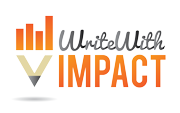More than 50,000 blog posts are published on LinkedIn every week.
What topics should you write about? How long should your posts be? How do you get your post tagged under a Pulse channel?
For answers to these and other questions, I invited LinkedIn Senior Editor Isabelle Roughol to join me on my new podcast, Write With Impact.
Isabelle recently relocated to Sydney (“the people are nice and the weather is perfect!”), after setting up LinkedIn’s editorial operations in Paris (“I miss the food!”).
During the course of our nearly 50-minute conversation, she offered several tips to writers just like you and me who are seeking to attract more views, likes and social shares to our posts.
Her friendly, intelligent voice was a refreshing reminder that there are indeed human beings behind the Matrix-like computer algorithm running LinkedIn’s massive global blogging platform (which is now open to 250 million of their 347 million members).
Like her colleagues around the world, Isabelle carefully curates what gets featured under the various Pulse channels, and contributes her own analysis and perspectives on the topics of the day.
Here is some of the advice she shared with me:
Sweat the headline and the first paragraph
“The headline is the door to your post, so make it intriguing enough without being too unclear about what the post is about”, Isabelle says. She suggests spending as much as half your time writing a great headline and first paragraph. Quoting one of her favorite French journalists: “there’s no use being clever in the fifth line if the reader doesn’t get past the fourth.”
She sees too many writers clear their throats and waste valuable time in the first paragraph or two before getting to the point of their post (a recipe for losing readers fast).
Put your unique twist on a trending topic
LinkedIn’s editors are looking for fresh analysis and commentary on the news stories of the day. Take a look at what’s trending, and offer your unique perspective on it. Okay, so the stock market took a hit. But tell how you’ve been affected by it, or what you think should be done about it. A new technology has been announced. So how does it affect your industry, or even your own job?
Be real
Don’t sound like a corporate press release. Avoid jargon. Be yourself. Be real.
Keep it brief
Like you, people are very busy, and have limited time to read long posts. Isabelle quotes her colleagues who suggest that you write “as much as it takes to make your point and no more.” She says that there seems to be a “sweet spot” for posts of between 500 and 900 words.
Anything longer and you’ll be testing your reader’s attention span, particularly if they’re on a mobile device, which is becoming the device of choice these days for reading LinkedIn content.
“Think of how much time you’ve spent writing your post. Well, the reader is similarly busy and may find it just as difficult to find the time to read all the wonderful content that you’ve provided.”
When I probed her about the heavily overused “listicle” format for structuring posts, she acknowledged the problem, and urged writers to use them sparingly. “If you need to use listicles, go ahead once in a while, but don’t use them in every post.”
Be choosy about your image
A good image is — along with a catchy headline — important for attracting more viewers. “Avoid stock images of two people shaking hands. Pick distinctive images that stand out. Images of people have a slight advantage in catching attention.”
“Don’t use text in your featured image because it won’t be legible anyway once the image is reduced to thumbnail dimensions on LinkedIn. Place it in the body of your post, if it’s needed at all”, she advises.
“And out of respect for our photographer friends, be sure you have the rights to use the image. Check if it offers a Creative Commons license that allows for modifications to the image.” Wikimedia Commons and flickr.com are two good sources for finding quality images that you can legally use in your posts (with proper attribution of course).
Invite your readers into a dialogue
Invite reader comments by asking a question at the end of your post. “It makes you look more approachable and increases the chance that someone will leave a comment.” Comments appear in members’ feeds, attracting more engagement with your posts.
Do respond to comments. It encourages others to weigh in with their own comments, and demonstrates that you are responsive. An active comment thread can make a post visible to more potential readers and for a longer period of time. “Some posts generate such a heated discussion that it gives life to a post for several more days.”
Add multimedia
Images and exhibits in the body of your post break up long chunks of text and make your post more visually engaging. Embedding a Slideshare presentation can help increase engagement as well, as many busy readers appreciate the chance to flip through content quickly without having to read through blocks of text.
Share it with your network
Don’t be shy about spreading the word about your post. Once you hit publish, make sure you share your post with your network: LinkedIn groups you belong to, your social media networks, your company intranet and newsletter, etc. All within reason, of course.
Tell the editors about it
You can alert LinkedIn’s editors by tweeting a link to your post with a quick pitch that explains why it’s worth featuring to @LinkedInPulse. Isabelle and her colleagues also interact directly with readers — she does her best to keep up with the stream of emails that come through. And if your post doesn’t get the attention you feel it deserves, don’t give up so fast! Try again. Remember: the editors are working through a mountain of content each day, so they might miss your gem of a post the first time around.
Quality wins the day
Focus on writing quality content that appeals to your target audience, and don’t fret over the number of views your post gets. “At the end of the day, quality content wins”, she says.
Would you add anything to this list? What strategies or guidelines do you use when writing posts on LinkedIn? Please leave a comment!


Thank you for the wonderful tips on linkedin posts